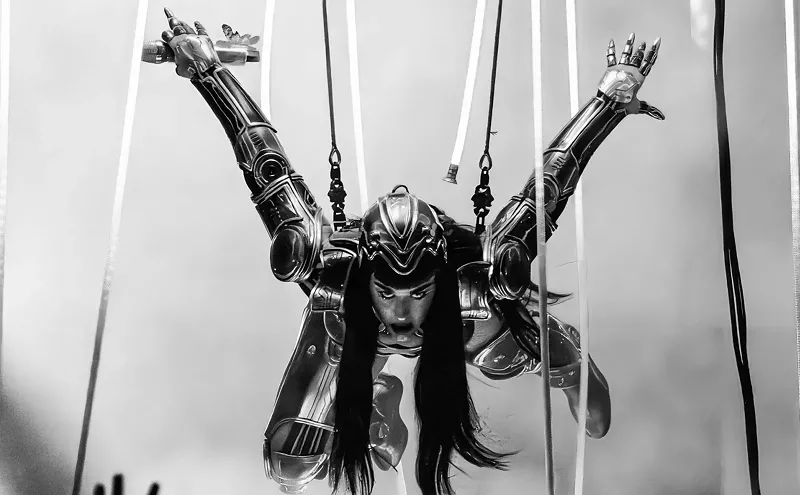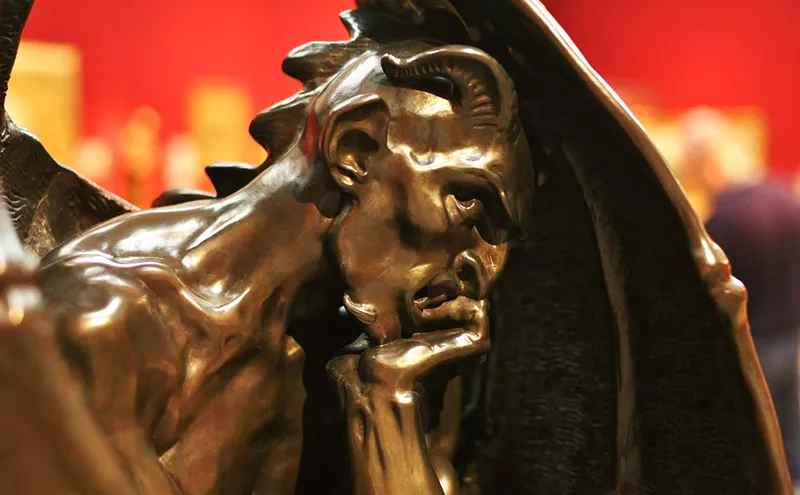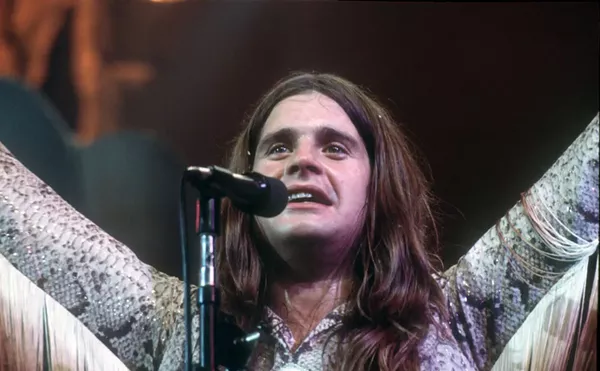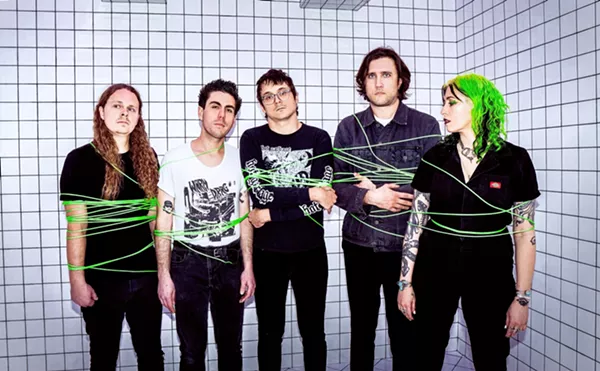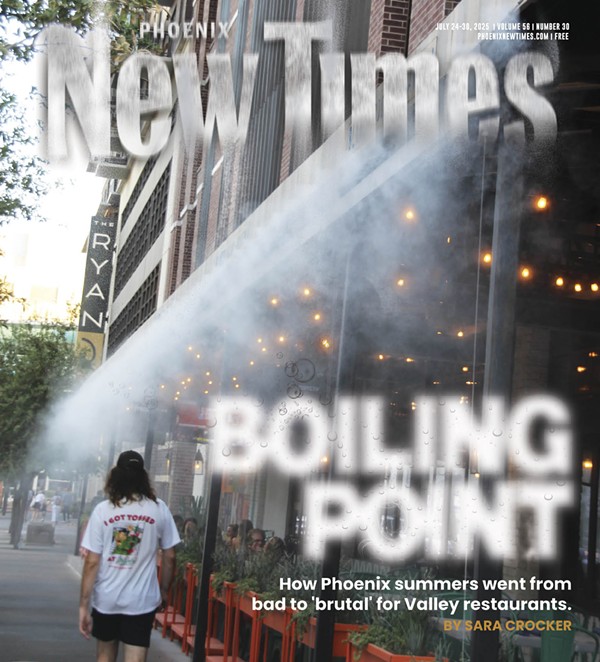Mark Grey, the Phoenix Symphony composer-in-residence for the 2007-08 season, has done just that and more to sonically represent the sacred Navajo creation story in his composition Enemy Slayer: A Navajo Oratorio. Grey's nearly two-year project takes the indigenous monster-slayer myth — a tale usually reserved for Navajo ceremony — and turns it into a single, 70-minute epic. The mixed-media piece will include a chorus of 140 singers, a full symphony orchestra, baritone soloist Scott Hendricks, and the Southwest landscape photography of Deborah O'Grady projected on a 12-by-21-foot screen.
As you can imagine, the work may not be the friendliest fare for classical music folks accustomed to Bach and Beethoven. But Enemy Slayer is part of the symphony's recent dedication — and a greater movement in American classical music — to bring in hipper events to attract younger fans. Last month, for example, the Symphony jolted audiences out of their wingtips and high heels during The Music of Led Zeppelin program at Dodge Theatre. The orchestra and a full-on amplified band transformed the retrospective to Jimmy Page, Robert Plant, et al., into a hard-hitting rock concert. "I've gone out on a limb with programming," says Phoenix Symphony music director Michael Christie. "I want Arizona to be the creative state and the symphony its center."
Christie is especially right about going out on a limb with Enemy Slayer. Because, on a larger, more culturally sensitive scale, Grey's massive undertaking will be, and already has been, met with a fair share of contention.
Purposely or not, Grey has made it a habit to shake up traditional music's old guard. The musician, composer, and sound designer recently created a conceptual audio design for John Adams' Doctor Atomic at the Lyric Opera of Chicago, marking the first time the theater housed amplification. Later this year, Atomic and its plugged-in elements will play at New York's Metropolitan Opera. (To date, the iconic hall has never used amplification.) "You can imagine some of the traditionalists in the opera world with their hair standing on edge that there's actually going to be microphones integrated into an opera," says Grey, who holds multiple composition and electro-acoustic degrees from California State University at San Jose.
An unlikely marriage between indigenous traditionalism and modern culture in Enemy Slayer is touchy territory, to say the least. In order to avoid a public backlash and to put a more complete face on the work, Grey teamed up with project librettist Laura Tohe, an ASU English professor and Diné (Navajo) who grew up on the Navajo Nation reservation. Before a single word or note was penned, the two met with elders on the reservation to discuss their intentions, as well as to gauge the council's reactions. Among the elders was Tohe's grandfather.
"From day one, the elders pointed out that we would get some heat from this. The main issue that was brought up was the idea of Navajo tradition and not giving away the secrets of their people. Because, on the Navajo Nation, you still have a lot of traditional Navajo who live without electricity and running water," Grey says. "They're not necessarily part of the 21st-century world of convenience that we live in, so the idea of trying to adopt a creation story into this Western form of oratorio was fairly mystifying to them."
Tohe adds, "They [the elders] wanted to know what the oratorio was and why we would want to take the story out of a ceremonial context."
After several meetings, Grey and Tohe decided to adopt the creation myth into modern times by keeping the monster slayer a more universally themed hero. The story chronicles a single protagonist (known as Seeker) who returns home from war to find that his support base has failed him. The 140-person chorus acts as an orchestral voice as Seeker attempts to expel his inner turmoil. There are no geographical clues or references to a specific war. Rather, the piece can be interpreted as the classic tale about a man going to war, fighting for his country, coming home, and receiving no love from his countrymen.
"The story follows the larger sense of the 'enemy way' ceremony, which is a Navajo ceremony of restoring one's self back to what they call the 'beauty way.' It's where you expel your demons out of your psyche, body and soul, then reground yourself back into the community, family, the Earth, and your world," Grey says. "It also balances on this line of the traditional Navajo and the contemporary Navajo . . . life at 1,000 feet, as opposed to life at 7,000 feet."
Though it's impossible that Grey and Tohe will completely avoid the crossfire inherent to a project of this magnitude, the two feel they've crafted a relevant art piece without sacrificing their artistic freedoms or sacred Navajo beliefs.
"The story is not a literal transition of the enemy slayer. It's a contemporary adaptation. I don't feel like I wrote anything that was disrespectful or took something out of context," says Tohe, who admits that she's under greater scrutiny than Grey because of her heritage. "I'm very aware that these things have happened in the past to non-Navajo people, where things were taken out of the culture or out of the religious and sacred context. I didn't want to do that. I am Navajo, and born and raised on the reservation. I speak the language. I feel like these are my stories and that I have to respect them, too."
There'll also be an authenticity to the work that one cannot get from surfing the Internet or plowing through library books. To gain a real idea of the physical landscape of the Navajo people, Grey took several trips to the high countries of Arizona and New Mexico. Whenever he could, he slept out in the open land by himself. He visited the Bisti Badlands in the northwest corner of New Mexico, a place where, Grey says, many Navajos believe the beasts in the monster-slayer legend originally lived. When he couldn't travel off the beaten path alone, he and photographer Deborah O'Grady hired an anthropologist to guide them by four-wheel drive. One such visit to Largo Canyon reveled rarely seen monster-slayer petroglyphs on the canyon walls.
Enemy Slayer will run in Boulder, Colorado, in the summer, and according to Grey, it could turn into a full-scale opera in the future. But first, the show must face a Phoenix audience that will include national music critics, members from the tribe-owned Navajo Times, and many Navajo people from all over the Southwest, including one who will bless the performance beforehand.
As for Grey's role during the performance, he says, "I will be sitting out in the crowd with white knuckles, as they say."




